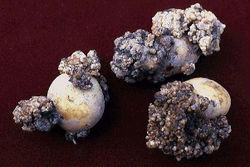Chytridiomycota

Source: USDA-APHIS-PPQ - Wikimedia Commons
Chytridiomycota - Chytridiales - (chytrids)
The chytrids are an ancient group of around 1,000 species of simple, mainly aquatic and saprobic fungi. Several are important plant pathogens like Synchytrium endobioticum which causes potato wart.
Asexual reproduction is through the formation of asexual sporangia which release motile diploid zoospores. These can germinate forming unicellular or multicellular structures. Some cells have branched threads, called rhizoids. The rhizoids attach the cells to a substrate (e.g. a plant cell) and absorb nutrients. Asexual, diploid sporangia are formed again in these structures.
Sexual sporangia are also formed in the diploid structures. They are typically thick-walled resting spores which can survive for many years. Upon germination, they release haploid zoospores. These form haploid structures, again sometimes with rhizoids, and produce flagellate sexual gametes. The motile gametes can be also called zoospores and have a similar structure. Male and female gametes fuse and form motile, diploid zygotes which finally form again diploid structures producing asexual sporangia. The Chytridiomycota are the only group of fungi which forms motile gametes.
The following genera are currently entered under this group: